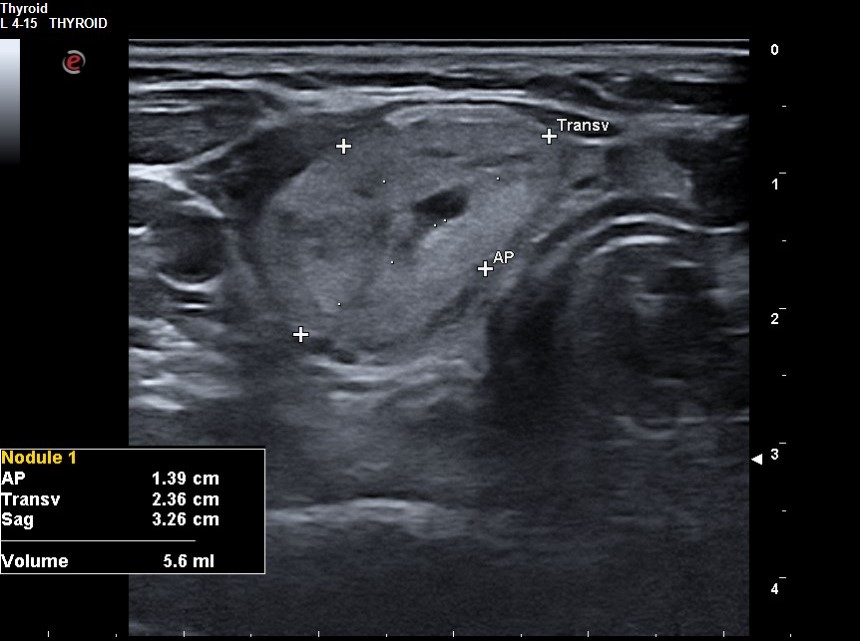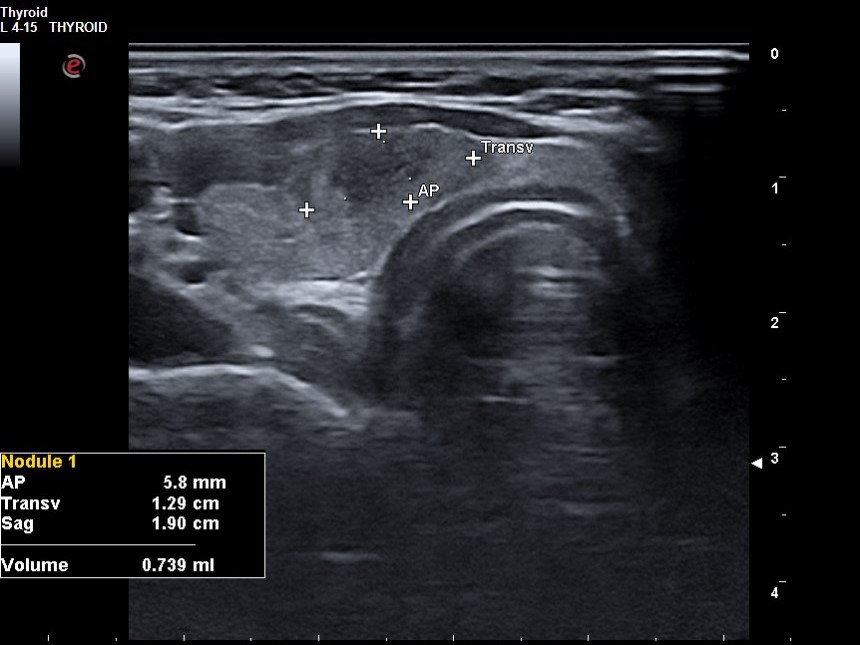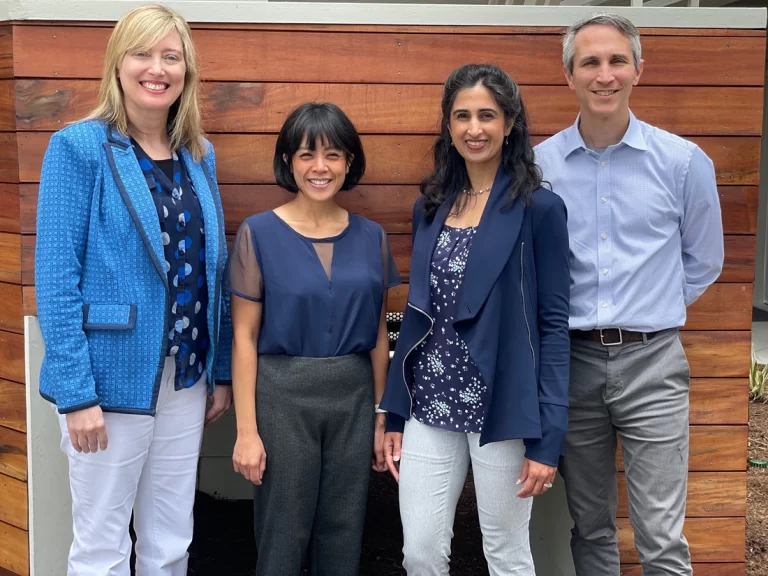A Cutting Edge, Non-Surgical Treatment for Thyroid Nodules
The thyroid gland, while small keeps the entire body functioning normally — from digestion, to the brain, heart and metabolism. We don’t usually think about it, until it stops working properly.
Thyroid nodules are relatively common. While most are benign and not life-threatening, they can still cause problems. Some benign thyroid nodules can cause cosmetic concerns, and even symptoms of discomfort, pressure, and problems with swallowing. Some nodules can even produce excess thyroid hormone.
Traditionally, the most common treatment options to address these problems have been: thyroid surgery, radioactive iodine therapy and/or thyroid medication. While these are safe options, they do have drawbacks.
Thyroid surgery is not a minor procedure. It requires general anesthesia, a hospital stay, and a period of recovery time which generally requires days off of work. There are risks of bleeding, scarring, hypothyroidism, damage to the vocal cord nerves, and calcium deficiency. Thyroid hormone medication requires regular blood tests, prescriptions, and office visits to determine the proper thyroid dosage. Managing thyroid medication is a lifelong process.
Similarly, radioactive iodine therapy has its challenges and is not an option for non-functional nodules. This procedure requires a period of isolation to protect others from exposure to the radiation, especially children. Additionally, there are potential side effects such as nausea, swelling and tenderness in the neck area, dry mouth and a metallic taste, and possibly an increased risk for cancer.
In the United States, these methods have been the only options for patients dealing with thyroid nodules — until now.


Pre-treatment volume of the nodule was 5.6 ml and the post 8-month size is 0.74ml. Slide the arrow side toside to see the difference.
Radiofrequency ablation (RFA), A common practice in other countries, is now available in the United States. Developed in the early 2000s, this non-surgical alternative shrinks thyroid nodules without compromising thyroid function and helps avoid long recovery times from thyroid surgery.
Radiofrequency ablation of the thyroid was first performed in 2002 by Professor Baek in South Korea and has since been continuously developed. Worldwide, approximately seven thousand procedures are performed each year.
Using radio frequency waves, radiofrequency ablation cauterizes (burns) thyroid nodules and cysts. This procedure is performed under local anesthesia to minimize discomfort and uses ultrasound guidance for insertion of a thermal probe into the thyroid nodule. Through selective heating of the probe tip, the nodule is destroyed. The cauterized (burned) tissue is then broken down by the body.
Compared to surgery, the primary advantages of radiofrequency ablation are:
Radiofrequency ablation is highly effective. Depending on the type, nodules shrink anywhere between 50-90% after one year, with approximately 60-80% on average.
Radiofrequency ablation is done in the office under sterile precautions. In most cases, medications will not affect the procedure. If you’re on blood thinning medication, you will need to stop taking it for a few days prior to the procedure at the discretion of your prescribing doctor. The procedure cannot be performed if you have a pacemaker, implants, are pregnant, or on medication for blood thinning. Don’t wear makeup, lipstick, or any metal jewelry on the day of the procedure.
You will be able to breathe, swallow and talk normally the entire time. Two grounding pads will be attached to your thighs to prevent skin burn. A pre-procedure Xanax or Valium will be given to decrease an anxiety about the procedure. The doctor and staff will ask you several times during the treatment how you are doing and whether you feel discomfort. This is unlike FNA of a thyroid nodule when we instruct you not to talk or swallow.
You will be covered with sterile cloths, and your neck will be disinfected. Your head will be placed on a small cushion in a slightly overstretched position. The doctor will use a very thin needle to place a local anesthetic under the skin in the area surrounding the thyroid gland.
A generator creates an electric circuit. Internally cooled electrodes with different active tip lengths are connected to the generator. Both are FDA approved and specifically designed for thyroid radiofrequency ablation.
During the procedure, the doctor will insert the probe into the nodules. The generator creates a high-frequency wave and sends it directly to the end of the needle tip. This heats the nodule tissue a few millimeters around the probe tip and treats it point by point.
An alternating electric current creates frictional heat around the electrode. Although this heat creates immediate damage to nodule tissue, the damage is significant only in regions very close to the electrode. Nodule tissue that is more remote from the electrode is heated slowly. When temperatures reach 46°C, irreversible cellular damage on the nodule occurs. When temperatures are increased to 60-100°C, the nodule tissue immediately coagulates.
You will often hear background noise and “cracking” sounds (similar to making popcorn) throughout the procedure. This means the generator and the water pump are doing their jobs and is normal.
You should set aside around 2 hours on the day of treatment. Depending on the size of the nodule to be treated, the procedure will take between thirty minutes to one hour. Pre-procedural care and post-procedural monitoring takes additional time. When the procedure is complete, you will be given an ice pack to cool the area.
The procedure is gentle and uses local anesthesia so most do not experience significant discomfort. The thyroid gland itself is not sensitive to pain, and the skin and surrounding area of the thyroid gland are anesthetized for the procedure. Only two to three percent of patients experience discomfort. This is usually a temporary burning sensation, similar to that experienced during anesthetizing at the dentist. In the event of severe discomfort, the procedure will be interrupted and more anesthetic will be injected again until there is no pain. Radiofrequency ablation does not cause any scarring to the neck. In most cases, one puncture of the skin is sufficient to treat the entire thyroid nodule but on occasion, two punctures are needed.
You will stay in a recovery area for at least 30 minutes after the procedure. You should be able to return to your regular daily activities immediately. However, you’ll be advised to limit certain activities for 1-2 days following the procedure. You will want to avoid the following activities during that time:
If you feel any abrupt change, you should notify your physician immediately.
In the weeks following the procedure, the cells of the treated thyroid nodule are metabolized by the body’s immune system. Most patients notice the nodule has already become smaller after just two to three weeks, with solid nodules taking longer than cystic nodules.
The targeted thyroid nodules are permanently destroyed from the high temperatures of the procedure. Immune cells of the body then break down the dead tissue, which shrinks the nodules. The amount reduced depends on the original size and nature of the nodules, with around 40–60% after three months and about 60–90% after one year.
All that remains of the nodule is residual scar tissue. The surrounding healthy thyroid gland remains completely unharmed and can continue to produce hormones so that daily thyroid medication is not required following the procedure.
Any difficulty swallowing, feeling of pressure or tightness of the throat or appearance of the nodule is usually significantly decreased or no longer detectable.
The Korean Society of Thyroid Radiology (KSThR) introduced its first guidelines in 2012, with a revision in 2018. According to the 2018 guidelines, radiofrequency ablation for treating benign thyroid nodules is recommended for patients with:
Radiofrequency ablation is not performed during pregnancy or on patients with implanted pacemakers or defibrillators.
Radiofrequency ablation is not recommended for patients with:
Before undergoing radiofrequency ablation, doctors will want to make sure your thyroid nodule is benign. This is confirmed through at least two ultrasound guided fine-needle aspiration (FNA) or core needle biopsies (CNB). In some cases, a single benign diagnosis may be sufficient.
Surgery is currently the standard treatment for primary thyroid cancer. However, in patients with primary thyroid cancer who refuse surgery or who are unsuitable for surgery, radiofrequency ablation can be considered as an alternative to surgery. For those patients who refuse surgery or who are at high surgical risk, radiofrequency ablation can also be performed for recurrent thyroid cancers in the thyroid gland area or lymph nodes located in the neck.
Clinical trials measured the rate of reduction, therapeutic success, changes in symptoms and cosmetic improvement of benign thyroid nodules.
For “cold” benign nodules (those that do not produce excess thyroid hormone), clinical trials have shown a mean reduction rate of 32.7 to 58.2% at one month, and 50.7 to 84.8% at six months. In most patients, nodule related symptoms and cosmetic problems also significantly improved or disappeared. In a long term follow-up study, radiofrequency ablation was effective over a four year period with the nodules consistently decreasing to 93.5%.
For “hot” benign thyroid nodules (those that do produce excess thyroid hormone) clinical trials have shown volume reduction rates of 52.6 to 70.7% at six months, and improved or normalized thyroid function in most patients. In a multi-center study, hyperthyroidism caused by “hot” nodules improved in all patients and was completely normalized in 81.8% of patients. This led to the conclusion that radiofrequency ablation can be considered an alternative to thyroid surgery or radioactive iodine therapy.
For most average sized nodules, one treatment will sufficiently decrease the size of the nodules. When nodules are close to vocal cord nerves, or with very large nodules, repeated procedures may be necessary.
Untreated areas of “hot” nodules may interfere with the improvement in thyroid function. In these instances, complete ablation is required. For this reason, more than one treatment session may be necessary to successfully treat “hot” nodules.
In a multi-center study of 1459 patients organized by the Korean Society of Thyroid Radiology, the overall complication rate following radiofrequency ablation was 3.3%. The major complication rate was 1.4%.
While uncommon, complications can be:
Although rare, a complication could require an inpatient hospital stay or follow-up treatment.
Following radiofrequency ablation, your physician will monitor the treated nodules with ultrasound scans after one month, three months, six months and twelve months.
In the final analysis, radiofrequency ablation (RFA) is an exciting alternative for patients who experience problems from benign thyroid nodules— with less pain, less downtime and no scarring. While there are specific types of patients who would be candidates, it is a safe and validated procedure that is now approved in the United States. With its long lasting effects, radiofrequency ablation is a breakthrough in treating the symptoms of thyroid nodules. Ultimately, your physician can help determine the most effective treatment option for you.
